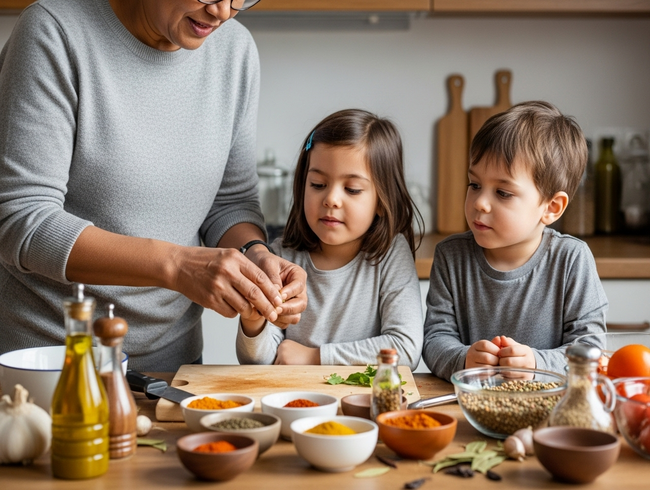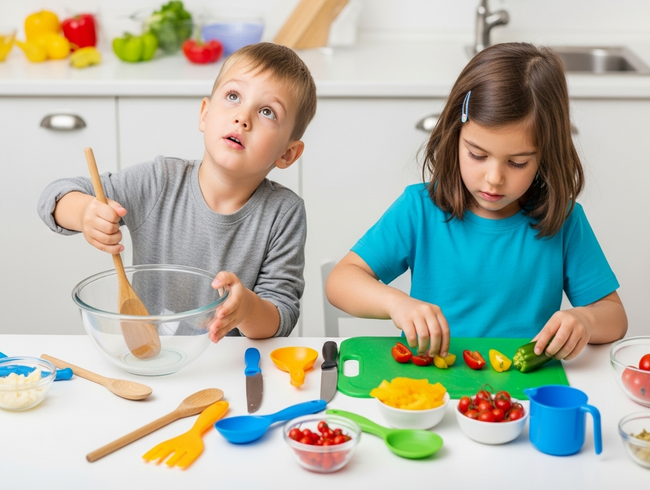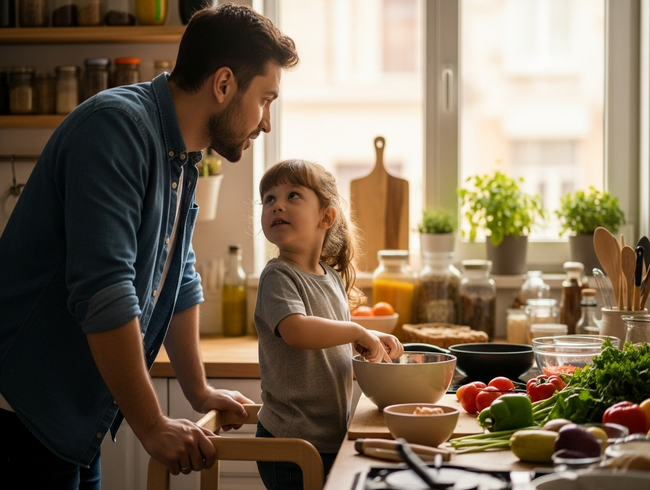As a chef who has nourished hundreds of children over my years in early learning kitchens, I’ve witnessed something magical: the most beautiful conversations often happen over a shared meal. Yet I hear the same concerns from families settling into new areas every day – parents worried their 3-5 year olds struggle with basic conversation skills.
Perhaps your little one finds it challenging to take turns in discussions, or they clam up when meeting new children at the playground. Maybe they struggle to start conversations or maintain them beyond a few words. These concerns are completely valid, especially when you’re thinking about school readiness and helping your child build confidence in new social situations during this big transition.
The beautiful truth I’ve discovered? Your kitchen already holds the secret to teaching children conversational skills naturally and joyfully.
The Overview: Transform Your Kitchen into a Conversation Classroom
You’re about to learn how to turn your daily meals into natural conversation practice sessions that will boost your child’s social confidence. Over the next few minutes, I’ll share five specific kitchen-based strategies that have helped countless preschoolers become confident little conversationalists.
Here’s what you’ll need: a willingness to slow down mealtimes by 15-20 extra minutes, your existing cooking supplies, and patience as your child learns through delicious trial and conversation. No special training required – just your loving presence and perhaps an extra tea towel for the inevitable spills!
This approach beautifully aligns with the Early Years Learning Framework principle that children learn best through everyday experiences. Your kitchen is about to become your child’s first and most comfortable conversation classroom.
Materials and Tools: Your Conversation-Building Toolkit
Before we begin cooking up conversations, gather these simple items you likely already have:
- Child-safe cooking utensils (wooden spoons, mixing bowls, measuring cups)
- A special “helper” apron that signals conversation cooking time
- Family photos showcasing your cultural food traditions
- A simple jar for conversation starter questions
- Ingredients for 2-3 family cultural dishes your child enjoys
- A timer to manage realistic expectations
Pre-planning steps:
- Choose 2-3 short, sensory-rich stories about your family food traditions
- Identify simple, safe cooking tasks your child can accomplish independently
- Set realistic expectations that your kitchen will be messier but your conversations richer
- Prepare yourself mentally to prioritise connection over perfection during meal prep
Remember, you’re creating a foundation for lifelong communication skills, not training a junior chef!
Step 1: Create Daily Greeting and Sharing Rituals
Estimated time: 5 minutes per meal
You’ll establish consistent mealtime routines where every family member shares one highlight from their day before the first bite. This matters tremendously because it gives shy children a predictable conversation structure whilst building essential turn-taking skills in a low-pressure environment.
Here’s how to set it up:
- Designate a sharing order (youngest to oldest works beautifully)
- Use a visual cue like passing a special wooden spoon or small bowl
- Model appropriate sharing length – aim for 30 seconds to 1 minute
- Celebrate each person’s contribution with genuine interest
The magic happens when your child realises they have a guaranteed voice at every meal. This confidence transfers beautifully to classroom discussions and playground interactions.
Pro Tip: Start with just one meal per day – dinner often works best as everyone’s settling into the evening rhythm. Once this feels natural, you can expand to other meals.

Step 2: Transform Cultural Food Stories into Conversation Gold
Estimated time: 10-15 minutes
You’ll weave stories about your family’s food heritage into cooking and eating experiences, creating natural conversation opportunities whilst celebrating your child’s cultural identity. This approach builds cultural pride while providing your child with personal stories they can confidently share with new friends.
Transform your cooking sessions by:
- Preparing 2-3 age-appropriate stories about how your family traditionally makes certain dishes
- Encouraging your child to ask questions about ingredients, cooking methods, or family memories
- Inviting them to repeat their favourite parts of the stories back to you
- Connecting food preparation to sensory experiences: “Feel how smooth this dough becomes when we knead it, just like Grandma taught me”
Our seasonal menu is designed not just for nutrition, but for exploration – and your home kitchen can follow the same principle. Each cultural dish becomes a conversation starter your child can proudly share.

Common Mistakes to Avoid
Before we continue, let’s address some pitfalls I’ve observed that can transform joyful kitchen conversations into stressful experiences:
Don’t overwhelm with too many strategies at once. Start with one approach and master it before adding another. Children thrive with predictable routines, not constant novelty.
Avoid turning mealtime into interrogation time. The goal is natural dialogue, not a question-and-answer session where you’re doing all the asking. Model conversations by sharing your own thoughts and observations.
Never pressure immediate perfect responses. Some children need processing time. Create comfortable silences and celebrate small steps rather than expecting eloquent speeches.
Don’t create cultural shame around heritage foods. If your child initially rejects traditional dishes, continue offering them without pressure whilst maintaining positive stories around your food culture.
Step 3: Set Up Question-Asking Through Simple Cooking Tasks
Estimated time: 15-20 minutes
You’ll involve your child in age-appropriate food preparation whilst actively encouraging their natural curiosity through questions about processes, ingredients, and choices. Hands-on activities naturally prompt inquiry skills because children’s minds become engaged through their senses.
Set up your question-rich cooking environment:
- Choose safe, manageable tasks like stirring sauces, sorting vegetables by colour, or decorating plates
- Model question-asking: “I wonder what will happen when we add the warm milk to this mixture?”
- Praise curiosity over correctness: “What an interesting question about why onions make us cry!”
- Encourage predictions: “What do you think this will smell like when it starts cooking?”
A trick I’ve learned for fussy eaters is that children who participate in cooking conversations become more adventurous eaters and more confident communicators. The kitchen becomes their laboratory for both flavours and language.
Pro Tip: Keep a simple list of open-ended questions nearby: “What do you notice about…?” “How do you think…?” “What would happen if…?” These prompts help when conversations naturally pause.

Step 4: Configure Choice-Making Conversations
Estimated time: Ongoing throughout meal preparation
You’ll offer meaningful food choices throughout cooking and eating, then discuss these decisions together. Choice-making requires children to express preferences verbally and develop reasoning skills – both essential for confident conversations with peers and teachers.
Configure your choice-rich environment:
- Offer 2-3 specific options rather than overwhelming open-ended choices: “Would you like to add carrots or capsicum to our stir-fry?”
- Ask follow-up “why” questions about their preferences in a curious, not testing tone
- Respect their decisions to build confidence: “You chose the red capsicum because you love the sweet crunch – excellent reasoning!”
- Share your own choice-making process: “I’m choosing to add ginger because it reminds me of cooking with my mum”
The kids’ surprising favourite is always feeling heard and valued in their choices. This confidence in expressing preferences translates directly to social situations where they need to communicate their needs and wants.
Step 5: Establish Gratitude and Reflection Conversations
Estimated time: 5 minutes
You’ll create end-of-meal rituals focused on gratitude sharing and reflection about your cooking experiences together. This develops emotional vocabulary and reflection skills that form the foundation for deeper, more meaningful conversations as your child grows.
Establish your reflection routine:
- Model gratitude language: “I’m grateful for the way you helped stir this soup so carefully”
- Ask about favourite cooking moments: “What part of making dinner together did you enjoy most?”
- Encourage appreciation for effort and ingredients: “Let’s thank the farmers who grew these beautiful vegetables”
- Reflect on learning: “What did you discover about cooking today that surprised you?”
This gentle practice builds your child’s ability to process experiences verbally and share emotions – skills that will serve them beautifully in forming friendships and navigating social challenges.
Pro Tip: Keep reflection questions positive and open-ended. Avoid turning this into a lesson review. Instead, model genuine curiosity about your child’s inner world and experiences.

Success: What Your Conversation-Ready Child Looks Like
After consistently implementing these kitchen conversation strategies, you’ll notice beautiful transformations in your child’s communication abilities. Your little one will begin initiating conversations naturally, asking thoughtful questions about the world around them, and taking turns in discussions without prompting.
You’ll see them sharing personal stories with growing confidence, showing genuine curiosity about others’ experiences, and expressing their thoughts and feelings with increasing vocabulary. Perhaps most importantly, they’ll demonstrate increased social confidence in new situations – essential for settling into new environments and building friendships.
Ready to see how our holistic, inquiry-based approach delivers confident communicators in our bilingual early learning environment? We invite you to book a tour to experience our unique approach and see how we bring cultural celebration and natural conversation to life in our daily routines. Contact True Maple at 03 7504 3524 or springvale@truemaple.com.au to arrange your visit and discover how we support your child’s social development journey.

